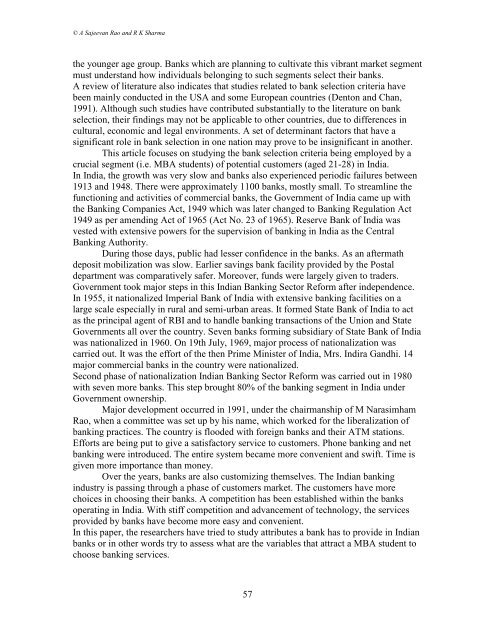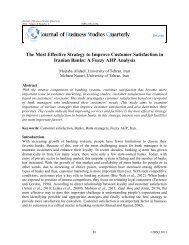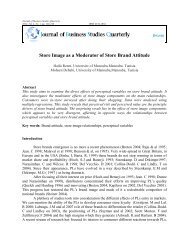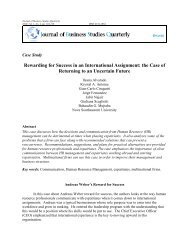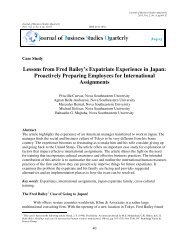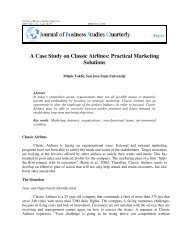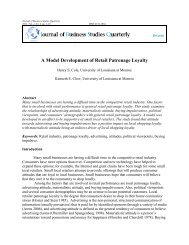Bank Selection Criteria Employed by MBA Students in Delhi
Bank Selection Criteria Employed by MBA Students in Delhi
Bank Selection Criteria Employed by MBA Students in Delhi
You also want an ePaper? Increase the reach of your titles
YUMPU automatically turns print PDFs into web optimized ePapers that Google loves.
© A Sajeevan Rao and R K Sharma<br />
the younger age group. <strong>Bank</strong>s which are plann<strong>in</strong>g to cultivate this vibrant market segment<br />
must understand how <strong>in</strong>dividuals belong<strong>in</strong>g to such segments select their banks.<br />
A review of literature also <strong>in</strong>dicates that studies related to bank selection criteria have<br />
been ma<strong>in</strong>ly conducted <strong>in</strong> the USA and some European countries (Denton and Chan,<br />
1991). Although such studies have contributed substantially to the literature on bank<br />
selection, their f<strong>in</strong>d<strong>in</strong>gs may not be applicable to other countries, due to differences <strong>in</strong><br />
cultural, economic and legal environments. A set of determ<strong>in</strong>ant factors that have a<br />
significant role <strong>in</strong> bank selection <strong>in</strong> one nation may prove to be <strong>in</strong>significant <strong>in</strong> another.<br />
This article focuses on study<strong>in</strong>g the bank selection criteria be<strong>in</strong>g employed <strong>by</strong> a<br />
crucial segment (i.e. <strong>MBA</strong> students) of potential customers (aged 21-28) <strong>in</strong> India.<br />
In India, the growth was very slow and banks also experienced periodic failures between<br />
1913 and 1948. There were approximately 1100 banks, mostly small. To streaml<strong>in</strong>e the<br />
function<strong>in</strong>g and activities of commercial banks, the Government of India came up with<br />
the <strong>Bank</strong><strong>in</strong>g Companies Act, 1949 which was later changed to <strong>Bank</strong><strong>in</strong>g Regulation Act<br />
1949 as per amend<strong>in</strong>g Act of 1965 (Act No. 23 of 1965). Reserve <strong>Bank</strong> of India was<br />
vested with extensive powers for the supervision of bank<strong>in</strong>g <strong>in</strong> India as the Central<br />
<strong>Bank</strong><strong>in</strong>g Authority.<br />
Dur<strong>in</strong>g those days, public had lesser confidence <strong>in</strong> the banks. As an aftermath<br />
deposit mobilization was slow. Earlier sav<strong>in</strong>gs bank facility provided <strong>by</strong> the Postal<br />
department was comparatively safer. Moreover, funds were largely given to traders.<br />
Government took major steps <strong>in</strong> this Indian <strong>Bank</strong><strong>in</strong>g Sector Reform after <strong>in</strong>dependence.<br />
In 1955, it nationalized Imperial <strong>Bank</strong> of India with extensive bank<strong>in</strong>g facilities on a<br />
large scale especially <strong>in</strong> rural and semi-urban areas. It formed State <strong>Bank</strong> of India to act<br />
as the pr<strong>in</strong>cipal agent of RBI and to handle bank<strong>in</strong>g transactions of the Union and State<br />
Governments all over the country. Seven banks form<strong>in</strong>g subsidiary of State <strong>Bank</strong> of India<br />
was nationalized <strong>in</strong> 1960. On 19th July, 1969, major process of nationalization was<br />
carried out. It was the effort of the then Prime M<strong>in</strong>ister of India, Mrs. Indira Gandhi. 14<br />
major commercial banks <strong>in</strong> the country were nationalized.<br />
Second phase of nationalization Indian <strong>Bank</strong><strong>in</strong>g Sector Reform was carried out <strong>in</strong> 1980<br />
with seven more banks. This step brought 80% of the bank<strong>in</strong>g segment <strong>in</strong> India under<br />
Government ownership.<br />
Major development occurred <strong>in</strong> 1991, under the chairmanship of M Narasimham<br />
Rao, when a committee was set up <strong>by</strong> his name, which worked for the liberalization of<br />
bank<strong>in</strong>g practices. The country is flooded with foreign banks and their ATM stations.<br />
Efforts are be<strong>in</strong>g put to give a satisfactory service to customers. Phone bank<strong>in</strong>g and net<br />
bank<strong>in</strong>g were <strong>in</strong>troduced. The entire system became more convenient and swift. Time is<br />
given more importance than money.<br />
Over the years, banks are also customiz<strong>in</strong>g themselves. The Indian bank<strong>in</strong>g<br />
<strong>in</strong>dustry is pass<strong>in</strong>g through a phase of customers market. The customers have more<br />
choices <strong>in</strong> choos<strong>in</strong>g their banks. A competition has been established with<strong>in</strong> the banks<br />
operat<strong>in</strong>g <strong>in</strong> India. With stiff competition and advancement of technology, the services<br />
provided <strong>by</strong> banks have become more easy and convenient.<br />
In this paper, the researchers have tried to study attributes a bank has to provide <strong>in</strong> Indian<br />
banks or <strong>in</strong> other words try to assess what are the variables that attract a <strong>MBA</strong> student to<br />
choose bank<strong>in</strong>g services.<br />
57


